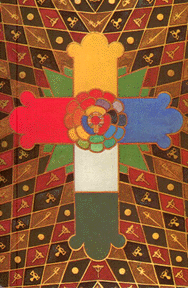Illusion, deception, bewilderment, hysteria, even madness, dreaminess, falsehood, error, crisis, "the darkest hour before the dawn", the brink of important change.
ק
ATU XVIII
ATU XVIII La Lune

The Ruler of Flux and Reflux.
The Child of the Sons of the Mighty
La Lune

The Ruler of Flux and Reflux.
The Child of the Sons of the Mighty
The Moon which goes following the Sun is also accompanied by tears of gold and pearls, to also mark what it contributes in its part to the advantages of the ground.
Pausanias teaches us in his description of Phocide, that according to the Egyptians, it was the tears of Isis which flooded each year the waters of the Nile and which thus rendered fertile the fields of Egypt. The historians of that country also speak about a drop or tear, which falls from the Moon at the time when the water of the Nile must grow bigger.
At the bottom of this card, one sees a crayfish or Cancer, either to mark the retrograde functioning of the Moon, or to indicate that it is at the time when the Sun and the Moon leave the sign of Cancer at which the flood caused by their tears arrives, at the rising of the Dog Star that one sees in the following card.
It may even be that the two reasons are joined together: is it not very common to be persuaded by a crowd of consequences which form a mass one feels too embarrassed to disentangle?
Between the two columns are two dogs which seem to bark against the Moon and to guard it: perfectly Egyptian ideas. These people, unique for their allegories, compared the Tropics with two palaces, each one guarded by a dog, which, similar to faithful gatekeepers, held back these stars in the middle region of the skies without allowing them to slip towards one or the other Pole.
The middle of the card is occupied by two towers, one on each side to indicate the two famous Pillars of Hercules, beyond which these two large luminaries never pass. These are not fantasies of commentators on customs. Clement, himself Egyptian, since he was of Alexandria, and who consequently knew what he was talking about, assures us in his Tapestries [or Stromates, Liv. V.] that the Egyptians represented the Tropics under the figure of two dogs, which, similar to gatekeepers or faithful guards, kept the Sun and the Moon from going to the Poles.
Pausanias teaches us in his description of Phocide, that according to the Egyptians, it was the tears of Isis which flooded each year the waters of the Nile and which thus rendered fertile the fields of Egypt. The historians of that country also speak about a drop or tear, which falls from the Moon at the time when the water of the Nile must grow bigger.
At the bottom of this card, one sees a crayfish or Cancer, either to mark the retrograde functioning of the Moon, or to indicate that it is at the time when the Sun and the Moon leave the sign of Cancer at which the flood caused by their tears arrives, at the rising of the Dog Star that one sees in the following card.
It may even be that the two reasons are joined together: is it not very common to be persuaded by a crowd of consequences which form a mass one feels too embarrassed to disentangle?
Between the two columns are two dogs which seem to bark against the Moon and to guard it: perfectly Egyptian ideas. These people, unique for their allegories, compared the Tropics with two palaces, each one guarded by a dog, which, similar to faithful gatekeepers, held back these stars in the middle region of the skies without allowing them to slip towards one or the other Pole.
The middle of the card is occupied by two towers, one on each side to indicate the two famous Pillars of Hercules, beyond which these two large luminaries never pass. These are not fantasies of commentators on customs. Clement, himself Egyptian, since he was of Alexandria, and who consequently knew what he was talking about, assures us in his Tapestries [or Stromates, Liv. V.] that the Egyptians represented the Tropics under the figure of two dogs, which, similar to gatekeepers or faithful guards, kept the Sun and the Moon from going to the Poles.
| Also see ATU XVIII: La Lune according to: | ||||
| Tarot de Marseilles (Gebelin) | Eliphas Levi | Golden Dawn (Regardie) | Aleister Crowley | Frater Achad |






























